Journey to Mars – San Pedro de Atacama, Chile
By Max Hartshorne
Photos by Paul Shoul

Traveling in this vast and empty northern desert of Chile, where a brutal sun gives way to a freezing night, the atmosphere is so charged from the minerals beneath one’s feet you can feel static in the mountains.
San Pedro de Atacama is an oasis visible far ahead as we drive the rail-straight road out of Calama. The road shimmers and is unendingly flat, in the moonscape desert all around you; San Pedro is the only green patch. It’s called the Valley of the Moon.
NASA tested out their Martian rover vehicle here, where these boulder-strewn flatlands look a lot like the photos of the red planet we’ve seen on TV.
The Andean Cordillera and Atacama Desert
San Pedro is located at the foothills of the Andean cordillera, which reaches an altitude of 6,100 meters in this area. The majestic and mystic volcano Licancabur (5,916 meters above sea level) is in front of the village, only 40 kilometers away. Licancabar, or ‘village hill’, was venerated by the Incas, who carried out ceremonies and left offerings at the top.
The town is laid out in a square grid; the streets are full of mountain bikers, donkey carts, and expedition minibusses. San Pedro is a town with a 500-year leftover head rush from the hallucinogenics taken so liberally by the Incas who once ruled here.
Ancient Drug Gear and Mummies

The city’s Catholic Museum, located on the town square, contains the world’s largest assemblage of ancient drug paraphernalia as well as many mummies, artifacts and dioramas showing the evolution of life from before the Incas.
There are cases and cases of little carved dope trays and various shapes and sizes of pipes and bong-like devices– a testament to the Inca’s firm belief in using substances to get in touch with God and nature.
San Pedro’s streets are just wide enough for vehicles to pass. Most of the shops and restaurants are located here on Caracoles Street. Peeking in the windows and open doors of the low-slung buildings, you see guides sitting with customers discussing excursions, and people dining next to fireplaces and fire pits.
Shangri-La in Atacama
It has been written in guide books that San Pedro de Atacama grows on people, that some travelers arrive here and never leave–the proverbial Shangri La. It is also true that tourism is the lifeblood of the economy since the only other source of jobs is two hours south at Calama, where the world’s largest open-pit copper mine sprawls in a four-kilometer spiral out of a former mountainside that is visible from space. Tours leave every day at 9:30 am.
Guiding tours or tending to tourists and agriculture are the main industries in San Pedro. Hiring one of the fifty available guide services is essential for experiencing the natural other-worldly attractions here. We chose Desert Adventure, a solid and reliable organization with a fleet of minibusses and vans capable of driving the terrible washboard rutted roads.
We appreciated the expertise of our guide Danilo Vidal, who was passionate about the place and provided an up-close look at its many wonders.
The Lascar Volcano
On our way to San Pedro, Danilo pointed out the conical shape of the Lascar volcano, which last erupted as recently as this year. The smoke from the volcano formed the only clouds we saw in this area’s remarkedly blue sky.

The lonely little town of Toconao with its 530 residents can be found en route to the mountain lagoons. Here you can visit the back courtyard of a little store and find alpaca and llama scarves and sweaters, and feed weeds to the animals who gave the wool.
Out in the desert, we stopped by a marker, four plain white tubes against the boiling sky. “This is the tropic of Capricorn,” Danilo said. He pointed to a path going far out into the desert. “This is the Inca Trail.”
This track was once traveled by the Inca, who developed a sophisticated society complete with irrigation systems and a complex language, and perished en masse when the Spaniards came in the 1500s. Many artifacts documenting this period’s clash of cultures of this period can be found in the town’s museum.
All around were volcanoes, mostly dormant, with ribbons of snow coming down from their
peaks. The altitude was about 13,500 feet. Our heads were light as we donned copious amounts of sunscreen and proper headgear, (required, and a floppy hat with a wide brim is a good idea). Our hearts quickened and a sense of lightness came to us on the altiplano this high up.
Flamingoes Feeding
As you hike over the ridge, a large blue oasis takes shape. Here, bounded by stark, rocky mountains, flamingoes feed on little red worms in the shallow and chilly water. The wind picks up and suddenly you’re glad you brought an extra layer to keep the chill from pounding you into submission.
The sense here is a challenge, that nature is throwing all she has at you, and if you’ve packed right and brought enough fleece and windproof jackets, you’ll survive to laugh about the cold and keep on with the hike to the second lagoon, it takes about two hours over 7 kilometers.

In these harsh conditions, only the hardiest prickly little plants survive, but animals abound: partridges, larger than in the U.S., skittered out of the way as we approached, pink flamingoes rival those seen in Boca Raton yards, and vicuna, which resemble a cross between a deer and a llama.
These docile creatures are prized for their fur, taken from the beasts with a comb and made into the finest sweaters, even finer than alpaca or cashmere.
Geysers Spouting
Another highlight of this strange region is the early-morning excursion to the Geysers of El Tatio, where more than 40 geysers, thermal wells and fumaroles blast up into the chilly early morning air. We had to leave the hotel at the ungodly hour of four am and endure a drive over the worst washboard rutted, curvy, hilly painful road you’ve ever seen.
But seeing these natural wonders going off as the sun comes up was worth it all. Later we watched people swimming in the very hot pools heated by this steaming water coming from deep below the desert.
We asked many of the people we met in Chile about what life was like under the Pinochet rule. Mainly, the answer was that there was no freedom, and people kept their heads down to avoid trouble.
One night MTV broadcast a poignant video showing mothers and wives marching in Santiago’s streets holding up posters with photos of those who had disappeared, demanding answers from the regime.

Another young woman we met told us how she hated communists. We asked her about the torture and missing people from that time. “Oh there were some excesses,” she answered blandly, but it wasn’t that bad. Danielo and others would strongly disagree.
January and February, although summer months, can bring sudden winter wind. Last year 46 soldiers were caught in such a wind and froze to death in minutes. This is another good reason to hire a guide. If you rented a car, you would be likely to return it damaged after driving the rutty roads to the geysers.
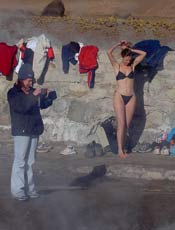
Dinner by the Fire Pit
Dinner was inside one of these holes in the adobe. We entered an open-air courtyard with a straw roof covering just the outside area. Rocks were arranged in a circle and a fire blazed. This is the style here, where most of the restaurants have fires in the center of these courtyards.
The blaze was a welcome sight, it felt good against the chill of the evening. Dinner usually included sopa, (soup) and often chicken breast with rice or pork chops. The local beer is called Escobar, a little stronger than the more common Crystal brew that is seen on all of the billboards.
A simple salad of beet greens and croutons was also on the menu.
The place filled up later on in the evening, so by about 10, it was totally full of Europeans in ball caps and outdoorsy looking twenty-somethings drinking beer and enjoying the warmth of the fire.
Chile’s Atacama desert is a place where the vastness of everything around you makes you feel small, yet the warmth of the fires matches the warmth of the locals. It feels like a place we’ll be reading much more about in the years ahead, as more and more travelers discover San Pedro de Atacama.
- Traveling to Valencia Spain - May 22, 2025
- Moments in Mallorca - April 14, 2025
- Málaga Spain: For the Sea, For the Spirit - February 3, 2025


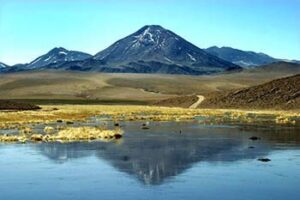

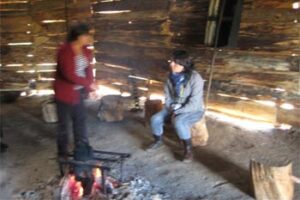
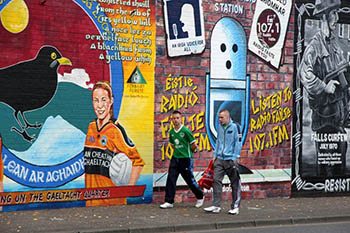
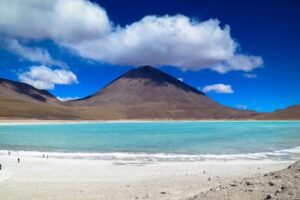

We are at Atacama right now